Sport means SUV compacting has gone Rogue
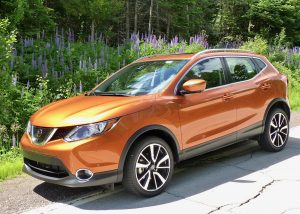
The Nissan Rogue is such a popular SUV it has expanded into a new and more compact vehicle, the Rogue Sport.
By John Gilbert
Funny how your perspective can change when assessing vehicles. Two or three years ago, my favorite SUVs were compact crossovers, and a perfect example was the Nissan Rogue.
With so many compact SUVs — or CUVs, if you prefer Crossover Utility Vehicles — available, the Rogue seemed to stand out, one of those tight, sporty, good-handling, and efficient vehicles that almost seemed to be custom made for my wife, Joan, and me.
Obviously, a few other people shared our view, because Nissan sold 360,000 of them, claiming the No. 1 spot in the crossover segment, and would be the largest selling “truck” if you eliminated the three big pickup trucks from Ford, Chevy and Dodge.
But suddenly, the Rogue seems too big! No, it hasn’t grown all that much. But there is now a Rogue Sport, which looks a lot like the Rogue from the front end, the front corner, and even the side and rear, until you look closely.
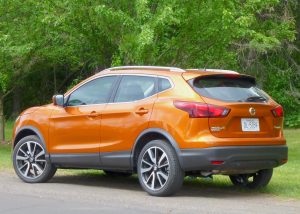
Nissan magically retained the style and nearly the same interior room although the Rogue Sport is a foot shorter than the popular Rogue.
The Rogue Sport is a foot shorter, and 6 inches lower, but it also is a lot more than just a miniturized Rogue. Honda, Toyota, Mazda, Ford, Chevrolet — nearly everyone — has come out with a reduced size SUV based on their smallest SUV.
The strategy was probably what you and I might have done if we had the design scalpal in our hands, which is simply to reduce dimensions from front to rear. But Nissan was a lot smarter than that. Most, if not all, of the competitors are left with a sprightly, sporty compact crossover, still with adequate room in the front buckets and adequate cargo space, but with tightly squeezed rear seat legroom.
But Nissan decided to reduce the one foot of length by carving into the cargo space, behind the second seat. It was an ingenious move, because the Rogue Sport has virtually the same front seat and second row room as the big Rogue, it just has less cargo space.
For those who might not need a third row seat, and might not have the need to haul as much cargo as the bigger Rogue, giving up a little cargo space is far preferable to cutting rear seat living room to near nothing.
The Rogue Sport is 172.4 inches long, with a 104.2-inch wheelbase. It has 42.8 inches of front legroom, and 33.4 inches of rear legroom. It also has surprisingly adequate cargo space of 33.3 cubic feet with the second row seat up, or 62.3 with it folded down.
The bigger Rogue has a strong 2.5-liter 4-cylinder engine, delivering 170 horsepower and 174 foot-pounds of torque in all-wheel-drive form, via a continuously variable transmission. The shorter and lighter Rogue doesn’t get the 2.5, but gets Nissan’s neat 2.0-liter 4, with 142 horsepower peaking at 6,000 RPMs and 147 foot-pounds of torque at 4,400 revs.
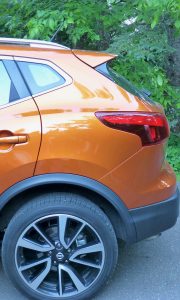
Close inspection reveals shorter rear section, the only hint that the Rogue Sport is a foot shorter.
Driving both of them, you don’t realize the Sport has a smaller engine, because its size and weight makes it feel quicker responding and generally quicker. Compact crossovers from companies like Nissan or Mazda energize the whole industry by proving even SUVs can be fun to drive and have sporty personalities.
Perhaps the biggest asset, after its size and visual appeal, is the price of the Rogue. The base S Rogue starts at $21,420; moving up to the SV gains larger 17-inch wheels and some other amenities, and starts at $23,020; the top SL, which I drove, starts at $26,070.
The SL moves up to 19-inch wheels, and all the top-line features, including leather interior, surround view, lane-departure detection and prevention, as well as the full suite of safety and connectivity items from the S and SV models.
The fact that I had the chance to spend a week with the Rogue SL a short time before the Rogue Sport SL showed up gave me the unique perspective of a better comparison. As mentioned, the Rogue has always been a family favorite, and we were doubly impressed by the Rogue Sport.
Open the door and climb into the front bucket, and you might be in the Rogue. Same with the back seat. But after driving the Rogue, and then the Rogue Sport, the next time I got into the “regular” Rogue the Rogue Sport never seemed too small, but the regular Rogue suddenly seemed, maybe, too big!


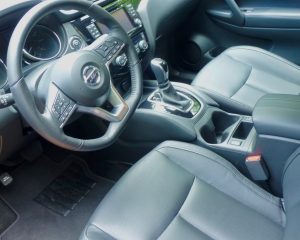
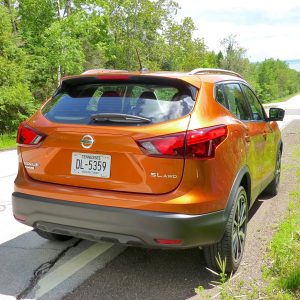
 John Gilbert is a lifetime Minnesotan and career journalist, specializing in cars and sports during and since spending 30 years at the Minneapolis Tribune, now the Star Tribune. More recently, he has continued translating the high-tech world of autos and sharing his passionate insights as a freelance writer/photographer/broadcaster. A member of the prestigious North American Car and Truck of the Year jury since 1993. John can be heard Monday-Friday from 9-11am on 610 KDAL(www.kdal610.com) on the "John Gilbert Show," and writes a column in the Duluth Reader.
John Gilbert is a lifetime Minnesotan and career journalist, specializing in cars and sports during and since spending 30 years at the Minneapolis Tribune, now the Star Tribune. More recently, he has continued translating the high-tech world of autos and sharing his passionate insights as a freelance writer/photographer/broadcaster. A member of the prestigious North American Car and Truck of the Year jury since 1993. John can be heard Monday-Friday from 9-11am on 610 KDAL(www.kdal610.com) on the "John Gilbert Show," and writes a column in the Duluth Reader.